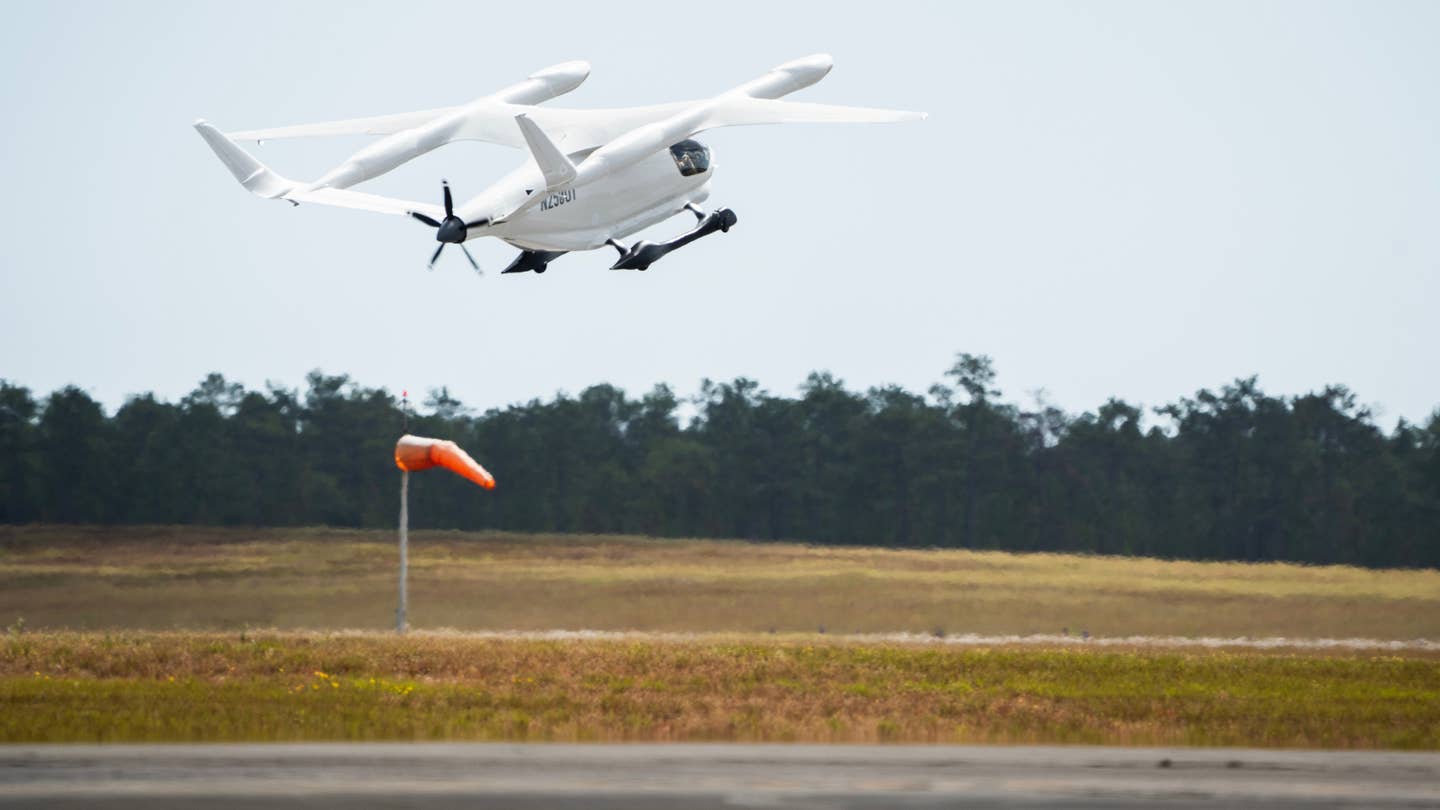Beta Technologies Concludes First Electric Aircraft Deployment for Air Force
Air Force pilots flew the electric aircraft manufacturer’s conventional takeoff and landing design in a series of experimental trials.

Beta’s electric Alia CTOL aircraft takes off from the runway at Eglin Air Force Base’s Duke Field in Florida. [Courtesy: Beta Technologies]
Manufacturer Beta Technologies is designing a conventional takeoff and landing (CTOL) aircraft. But the aircraft is anything but conventional, as evidenced by a series of experimental trials with the U.S. Department of Defense.
Beta on Monday announced that it concluded its first deployment with the DOD at Eglin Air Force Base’s Duke Field (KEGI) in Florida. The three-month campaign involved Beta’s electric Alia CTOL, a mobile flight simulator, and the company’s built-in-house charging system.
U.S. Air Force pilots took Alia out for on-base and cross-country missions, completing performance evaluations and pilot and maintenance assessments. They also conducted experimental operations and training with the 413th Flight Test Squadron, an Air Force unit stationed at Robins Air Force Base in Georgia.
The deployment was part of the Agility Prime program, the vertical lift division of the Air Force’s innovation arm, AFWERX. Beta and AFWERX’s relationship dates back to 2020, when the Air Force unit first contracted the manufacturer.
According to Beta, the three-month campaign is the next phase of a larger Air Force developmental test and evaluation (DT&E) effort to gauge the fit of electric aircraft for DOD missions. These could include critical resupply, cargo delivery, and personnel transport, use cases that mirror real-life operations the Air Force has planned.
The Alia CTOL arrived at Duke Field in October after flying 1,500 nm down the East Coast. During the flight, it traveled through Class B airspace in Boston and New York City. Alia also became the first electric aircraft to fly through Washington, D.C.’s flight restricted zone, en route to a stop at Joint Base Andrews.
In addition to flying Alia, Air Force pilots used Beta’s MobileDome simulator to rehearse flights, practice emergency procedures, and obtain feedback from DOD subject matter experts. Last year, the manufacturer installed a Level 3 DC fast-charger—the first electric aircraft charging station at a DOD site—to juice up Alia between test flights.
Major Milestones
Together, Beta and the 413th Flight Test Squadron assessed Alia’s flight operations, maintenance support, and ability to identify infrared signatures, among other tasks. The missions out of Duke Field ranged from short sorties to extended flights, averaging $15 per flight in energy costs.
One key achievement was the first simulated casualty evacuation with an electric aircraft. The experiment demonstrated how Alia could improve response times at forward operating bases (FOBs) in foreign territory. A Lockheed Martin HH-60W rescue helicopter carried a simulated casualty halfway to medical care, but Alia finished the mission, relieving the helicopter and its crew earlier than currently feasible.
The exercise also showed how electric aircraft can reduce evacuation resource requirements. For a sample trip, a Lockheed C-130 Hercules would require a crew of at least three and expend about $1,600 in fuel. But Alia could complete the same mission with a two-person crew and an energy cost of just $5 in electricity.
Alia also completed a Maintenance Recovery Team (MRT) mission, flying to a nearby Air Force base to collect parts, then back to Duke to service a simulated aircraft. The aircraft flew a distance normally relegated to driving, which the DOD said could open cost and workforce savings.
For example, the cost estimate for a maintenance response of a home-unit based Alia, covering two flight legs, is about $25 worth of electricity and an hour of flight time. A standard Ford F-250 pickup covering the same geographical distance would spend about $45 on fuel and drive for four hours.
Those faster response times could enable same-day maintenance and reduced aircraft downtime. The latter could in turn eliminate unexpected DOD lodging costs or the cost of transport to recover fixed aircraft.
While Air Force pilots whizzed around the sky conducting experiments, Beta pilots flew Alia from Duke Field to Valdosta, Georgia, where the company commissioned a new charger at Valdosta Regional Airport (KVLD).
A Key Partnership
Since collaborating with AFWERX in 2020, Beta has gone on to achieve several electric aviation firsts with the Air Force’s help.
In 2021, it became the first electric aircraft manufacturer to receive airworthiness approval from the military for crewed flight. The following year, it conducted the industry’s first and only airman flight with test pilots from the Air Force and Army. Also in 2022, Alia completed a groundbreaking eight-leg, 1,219 nm cross-country flight spanning six states.
Those achievements may not have been possible without AFWERX’s help. Based on Beta’s comment that its recent deployment is only the “next phase” in a grander plan, the DOD may continue its relationship with the manufacturer. The department is also working with rival air taxi manufacturer Archer Aviation and several other developers of electric aircraft.
If all goes according to plan, Beta’s Alia CTOL will enter service in 2025, followed by an electric vertical takeoff and landing (eVTOL) variant in 2026. In October, the company opened a 188,500-square-foot production facility, where it will begin manufacturing when the time comes.
Like this story? We think you'll also like the Future of FLYING newsletter sent every Thursday afternoon. Sign up now.

Subscribe to Our Newsletter
Get the latest FLYING stories delivered directly to your inbox






